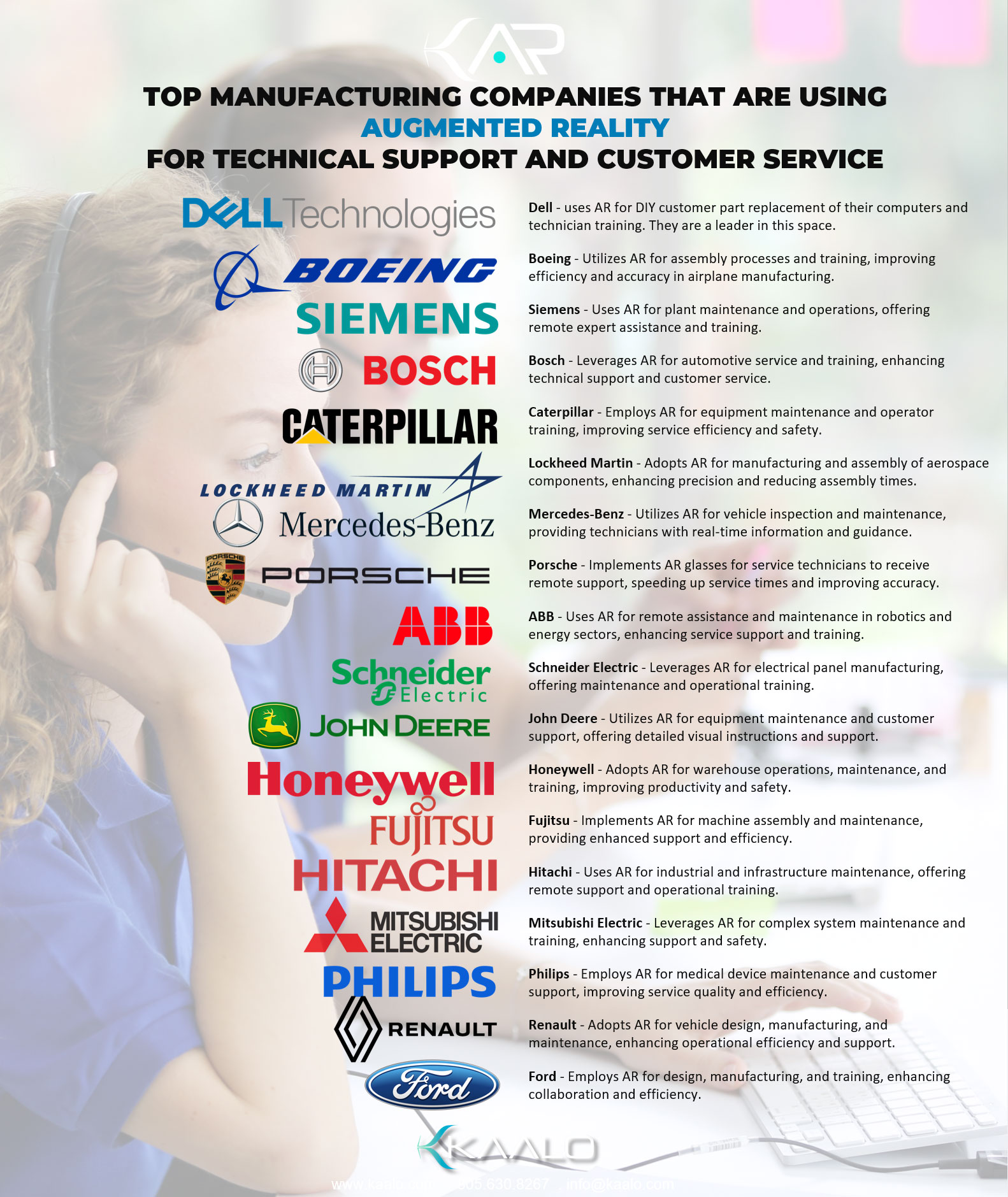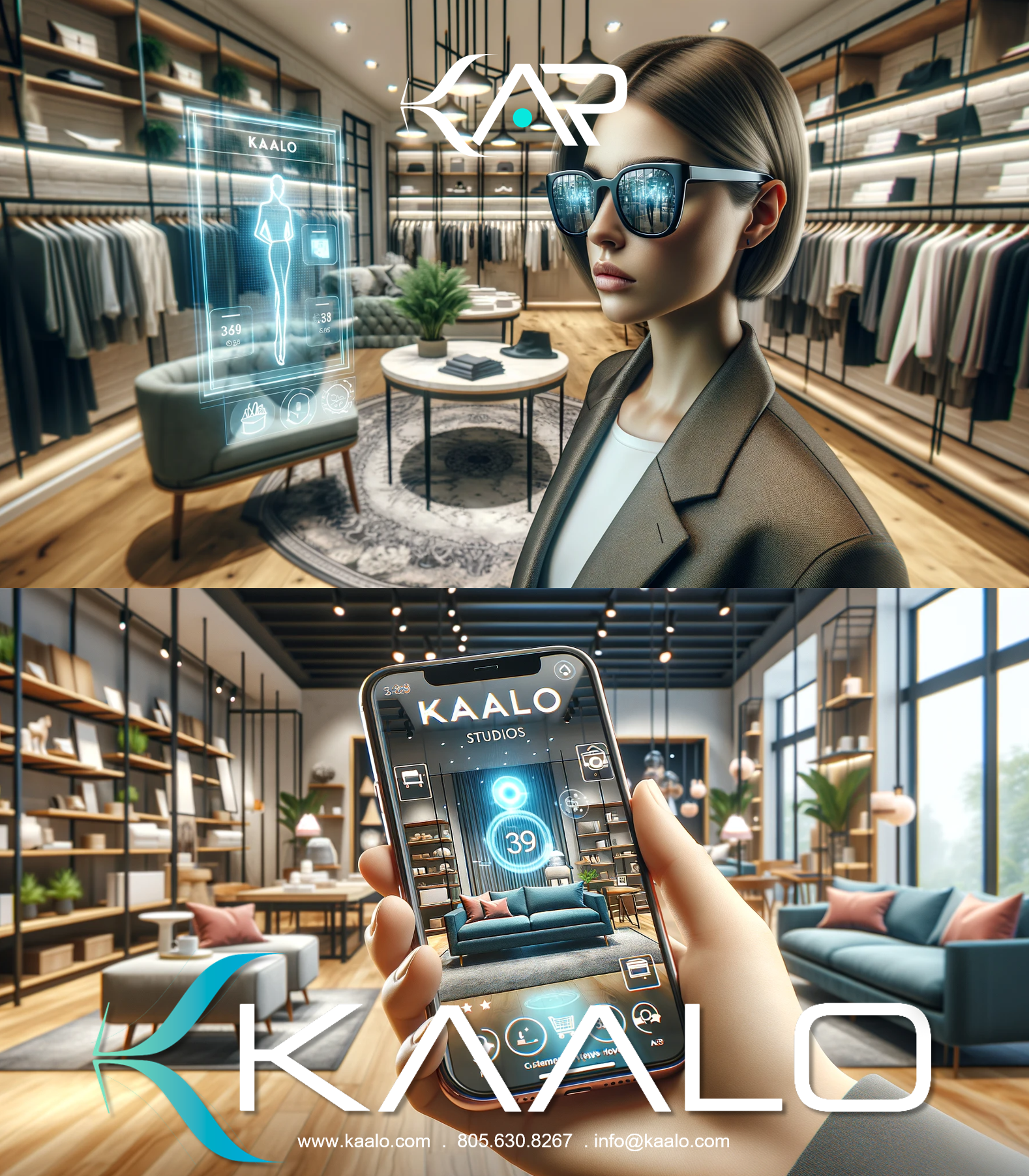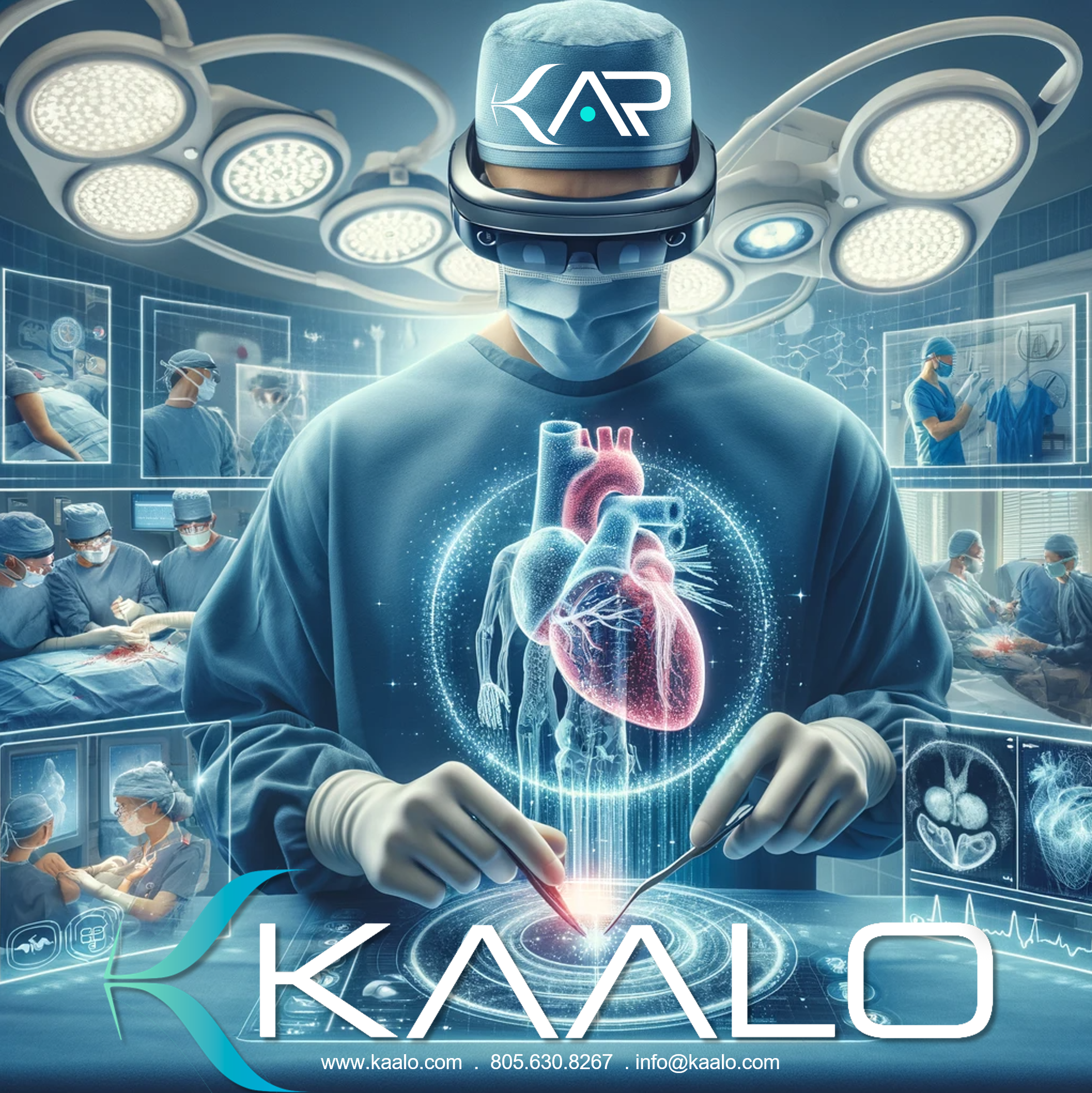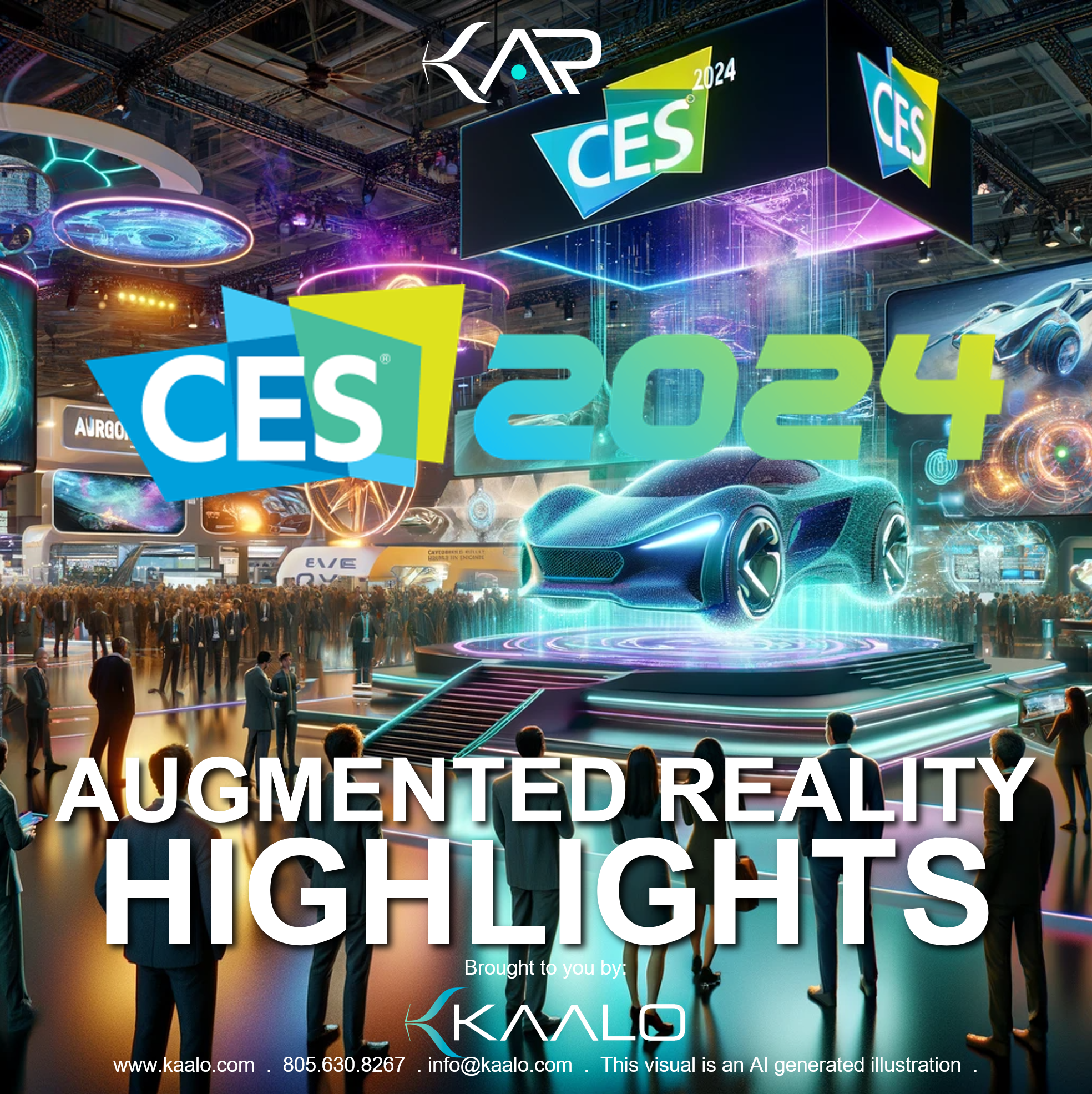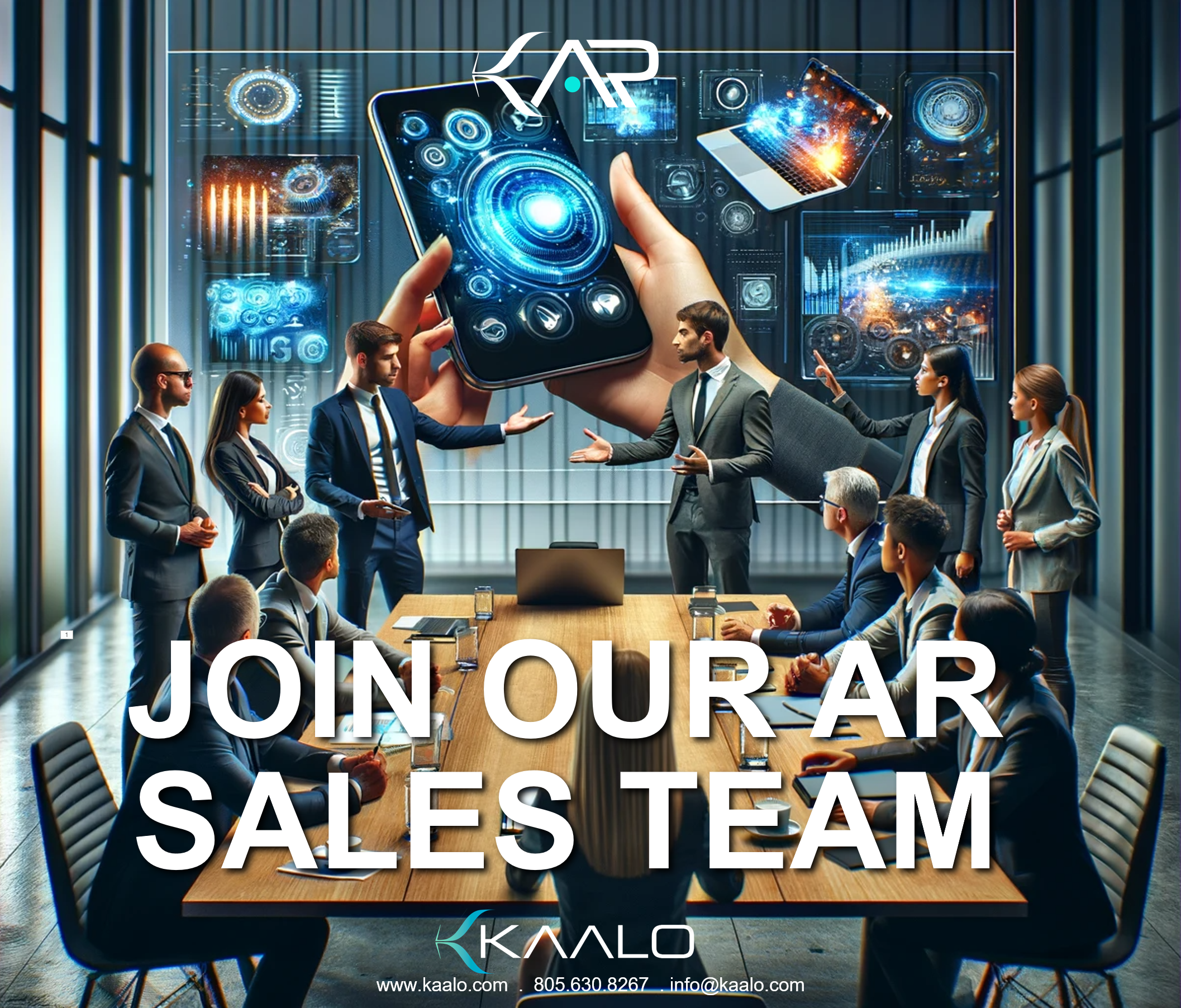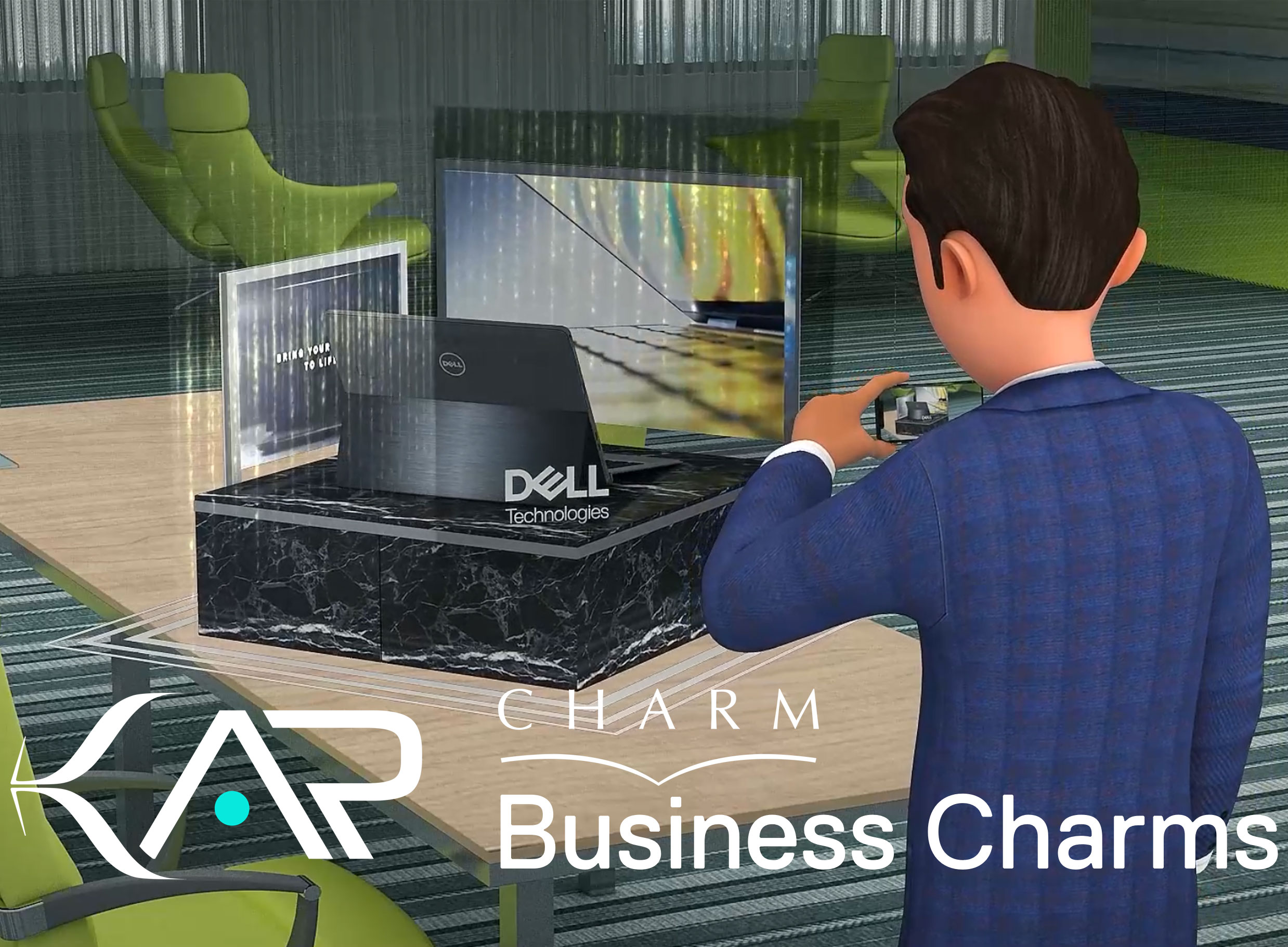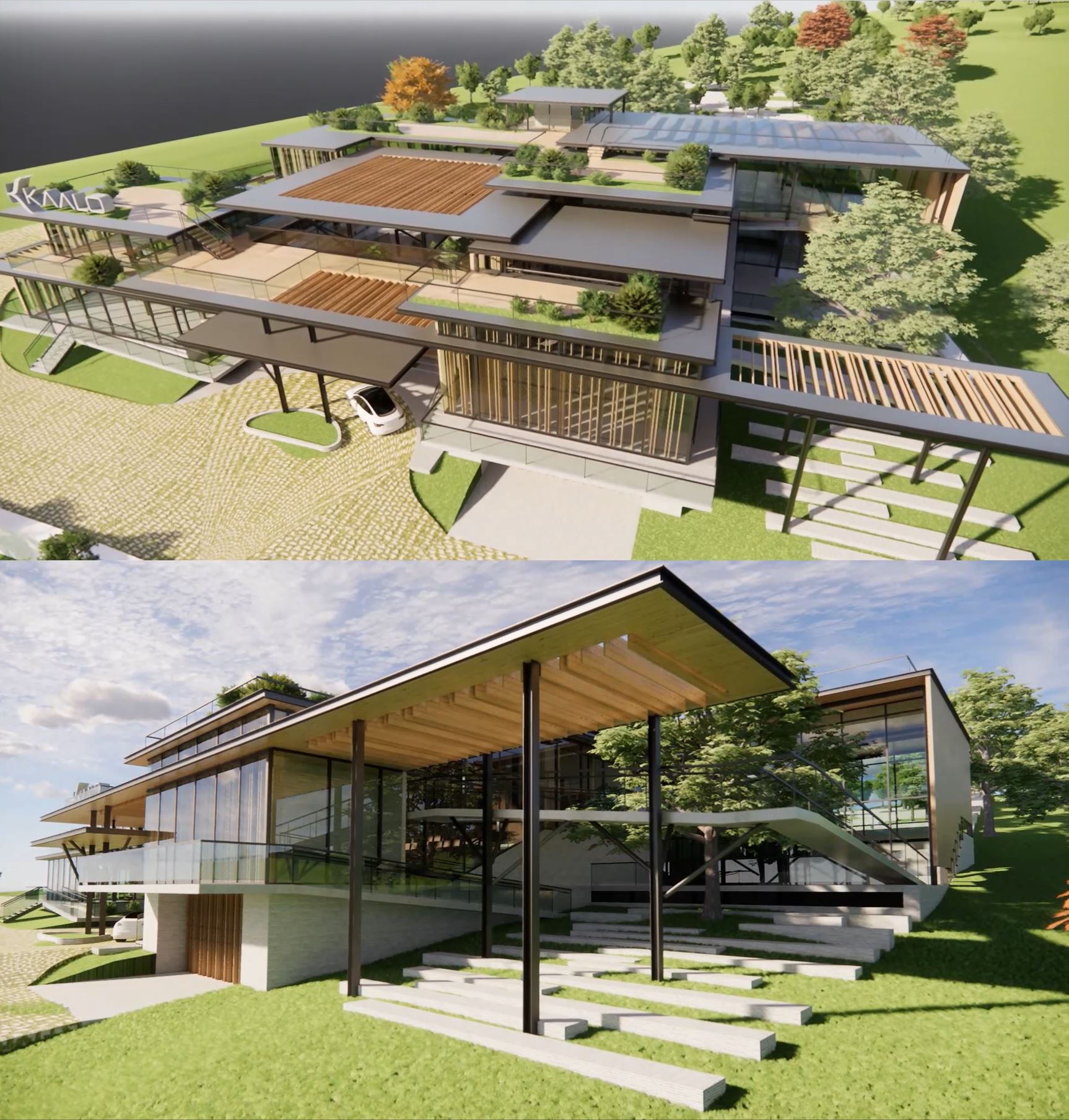Manufacturing companies leverage AR to provide real-time assistance, training, maintenance, and to improve the customer experience. Below is a list of top manufacturing companies that have been recognized for using AR technology in these areas.
Dell – uses AR for DIY customer part replacement of their computers and technician training. They are a leader in this space.
Boeing – Utilizes AR for assembly processes and training, improving efficiency and accuracy in airplane manufacturing.
GE Healthcare – Implements AR for service and maintenance of medical devices, providing remote support and training to technicians.
Siemens – Uses AR for plant maintenance and operations, offering remote expert assistance and training.
Bosch – Leverages AR for automotive service and training, enhancing technical support and customer service.
Caterpillar – Employs AR for equipment maintenance and operator training, improving service efficiency and safety.
Lockheed Martin – Adopts AR for manufacturing and assembly of aerospace components, enhancing precision and reducing assembly times.
Mercedes-Benz – Utilizes AR for vehicle inspection and maintenance, providing technicians with real-time information and guidance.
Porsche – Implements AR glasses for service technicians to receive remote support, speeding up service times and improving accuracy.
ABB – Uses AR for remote assistance and maintenance in robotics and energy sectors, enhancing service support and training.
Schneider Electric – Leverages AR for electrical panel manufacturing, offering maintenance and operational training.
Ford – Employs AR for design, manufacturing, and training, enhancing collaboration and efficiency.
Honeywell – Adopts AR for warehouse operations, maintenance, and training, improving productivity and safety.
John Deere – Utilizes AR for equipment maintenance and customer support, offering detailed visual instructions and support.
Fujitsu – Implements AR for machine assembly and maintenance, providing enhanced support and efficiency.
Hitachi – Uses AR for industrial and infrastructure maintenance, offering remote support and operational training.
Mitsubishi Electric – Leverages AR for complex system maintenance and training, enhancing support and safety.
Philips – Employs AR for medical device maintenance and customer support, improving service quality and efficiency.
Renault – Adopts AR for vehicle design, manufacturing, and maintenance, enhancing operational efficiency and support.
These companies are at the forefront of integrating AR into their manufacturing and service processes, showcasing the diverse applications of AR improving operational efficiency and customer service.
Contact Kaalo to take your Customer Service to a whole new level. [email protected]; 805.630.8267; www.kaalo.com
#AR#Techsupport#Customerservice#KaaloAR#NextGenManufacturing#CustomerSatisfaction#RightToRepair
Retail – both Big Box and E-Commerce is fast changing with AR! They have undergone a major transformation in recent years, and Kaalo is at the forefront of this evolution. Our cutting-edge WebXR, WebGL, and Mobile AR solutions are changing the way customers shop, interact with products, and make purchasing decisions.
Imagine walking into your favorite store, and with a simple tap on your smartphone, you can instantly access detailed product information, reviews, and even visualize how that new piece of furniture will look in your living room. That’s the power of Mobile AR!
Kaalo is committed to improving customer experiences and boosting sales for retailers. Our AR technology bridges the gap between the online and offline shopping worlds, creating immersive and personalized experiences that captivate shoppers and drive conversions.
How are we doing it? Our team of experts has developed AR solutions that seamlessly integrate into retail environments. From virtual try-ons for clothing and accessories to interactive product showcases, Kaalo’s Mobile AR is enhancing the retail landscape in unprecedented ways.
The results speak for themselves. Retailers partnering with Kaalo have seen increased foot traffic, higher conversion rates, and a significant boost in customer engagement. We’re not just keeping up with the times; we’re shaping the future of retail.
Whether you’re a brick-and-mortar store looking to thrive in the digital age or an e-commerce giant seeking to provide more immersive shopping experiences, Kaalo has the technology and expertise to make it happen.
Join us in reshaping the retail industry with AR Technology. Together, we can create unforgettable shopping journeys and drive business growth like never before. Reach out to us today, and let’s explore the possibilities! www.kaalo.com 805.630.8267 [email protected]
#RetailAR#KaaloAR#EcommerceAR#WebXR#RetailInnovation#CustomerExperience#NextGenDesign
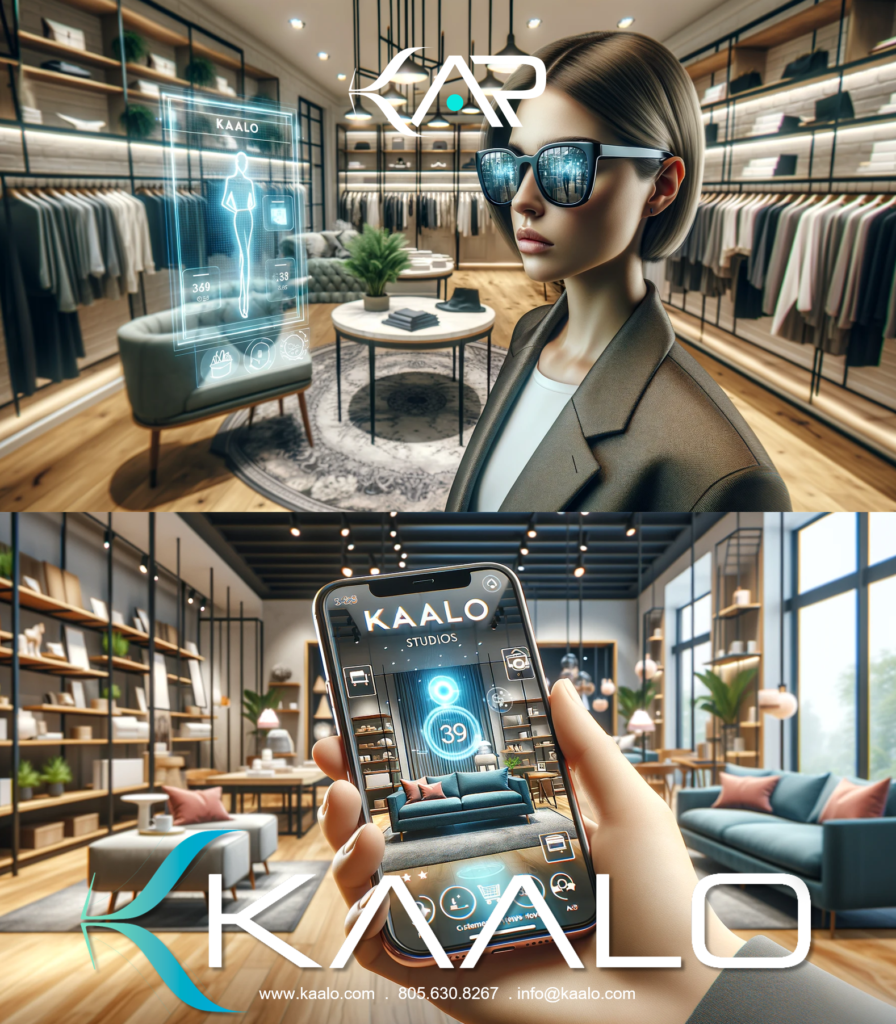
At Kaalo, we are excited to announce our commitment to serving the medical industry in the near future with our current capabilities in Augmented Reality (AR) technology.
In the medical field, precision and efficiency are paramount, and that’s where AR comes into play. Imagine surgeons having access to real-time, 3D holographic images of a patient’s anatomy during surgery, or healthcare professionals using AR glasses to enhance their diagnostics and treatment processes.
Our dedicated team at Kaalo has been hard at work, preparing to leverage our expertise in AR to develop customized solutions that will streamline medical procedures, improve accuracy, and enhance patient outcomes. We believe that by merging technology and medicine, we can elevate the quality of care and revolutionize the healthcare industry.
Here are a few ways Kaalo will soon make a difference:
1️⃣ Surgical Precision: Our AR applications will assist surgeons in performing complex procedures with greater precision, minimizing risks and ensuring the best possible outcomes for patients.
2️⃣ Medical Training: We are in the process of developing immersive AR training modules for medical students and professionals, providing them with realistic hands-on experiences to hone their skills. Our upcoming facility in Austin, Texas will host these training sessions as well.
3️⃣ Remote Consultations: With upcoming AR glasses solutions, we will enable remote consultations, connecting patients with specialists from the comfort of their homes, ensuring timely and expert care.
4️⃣ Patient Engagement: AR technology will also play a crucial role in patient education and engagement, helping individuals better understand their conditions and treatment plans.
Our commitment to innovation and dedication to improving patient care drive us forward. We’re excited about the future possibilities of Mobile AR technology in healthcare, and we look forward to serving the medical industry with our current capabilities.
If you’re as passionate about the intersection of technology and healthcare as we are, let’s connect and explore how we can collaborate to shape the future of medicine together. Feel free to reach out, and let’s make a difference! www.kaalo.com[email protected] 805.630.8267
#MobileAR#HealthcareInnovation#PatientCare#KaaloLLC#ARTechnology#MedicalAdvancements

AR is changing the game across various industries, and CES 2024 has been a testament to its transformative power. Here are AR highlights Kaalo thought noteworthy:
AR GLASSES HIGHLIGHTS:
1. MetaVision 5: Meta Platforms, Inc. unveiled MetaVision 5, advanced AR glasses with hand tracking, spatial audio, and a wide field of view, poised to transform consumer and enterprise applications.
2. Microsoft HoloLens 4: Microsoft introduced HoloLens 4, a lighter and more comfortable AR headset with improved holographic displays, gesture recognition, and app compatibility.
3. Magic Leap One 2.0: Magic Leap presented the Magic Leap One 2.0, offering enhanced spatial computing experiences, better graphics, and an intuitive interface.
4. Epson Moverio BT-50: Epson showcased the Moverio BT-50 AR glasses for industries like healthcare and logistics, featuring a high-resolution display and extensive app compatibility.
5. Nreal Air 2: Nreal displayed the Nreal Air 2, stylish and lightweight AR glasses for everyday use, providing an extended field of view and smartphone integration.
6. Oculus AR Prototype: Oculus teased an early AR glasses prototype, hinting at the fusion of VR and AR in a sleek device.
MOBILE AR HIGHLIGHTS:
1. Apple ARKit 5: Apple’s ARKit 5 boasted improved object recognition, indoor navigation, and real-world integration for iOS app developers and users.
2. Google ARCore Updates: Google enhanced ARCore with better tracking, environmental understanding, and seamless integration into Android apps.
3. Snapchat AR Lenses: Snapchat wowed with creative AR filters and lenses, offering fun and interactive ways to engage with the environment.
4. IKEA AR Home Planning: IKEA’s AR home planning app allowed users to visualize furniture in their homes, enhancing the shopping experience.
5. Niantic AR Gaming: Niantic unveiled AR games blending the real world with virtual elements, encouraging exploration.
6. Automotive AR Navigation: Car manufacturers showcased AR navigation apps that overlay guidance on windshields for a safer driving experience.
7. AR Shopping Apps: Retailers introduced AR shopping apps for virtual try-ons, simplifying and enhancing the shopping process.
These innovations exhibited at CES 2024 demonstrate the rapid integration of augmented reality into various industries and everyday life.

Calling all Tech Unicorns! Kaalo’s AR Sales Team Needs YOU!
🌟 Join the Augmented Reality Revolution at Kaalo in Austin, TX! 🚀
Are you ready to shape the future of AR technology? Kaalo, a cutting-edge design and technology company, is on the lookout for dynamic individuals to join our Sales Team at Kaalo Studios in Austin, Texas.
🔍 We’re seeking passionate Sales Professionals in various roles, including:
✨ Sales Interns ✨ Sales Specialists ✨ Sales Managers ✨ Sales Directors ✨ Contract Sales Representatives
This is an international search seeking to expand Kaalo’s reach worldwide.
If you’re a visionary in Augmented Reality, driven by innovation, and eager to be a part of a dynamic team, we want YOU to be a part of our journey! This is your chance to be at the forefront of the AR industry, with an opportunity to work alongside the best in the business.
If you know someone who fits any of these roles or if you’re interested in joining our team, reach out to us. Help us find the next AR superstar! Share this post and let’s connect with talent that shares our passion. Thank you in advance!
To explore these exciting opportunities, send us a message today at [email protected] or DM. Check us out at www.kaalo.com for details of each role. Let’s create the future of Augmented Reality together! 🌐
#KaaloStudios#AugmentedReality#SalesJobs#AustinTX#JoinUs#Innovation#TechCareers#SalesInterns#SalesSpecialists#SalesManagers#SalesDirectors
Get ready, Kaalo world, because Augmented Reality (AR) is about to blow your mind in 2024! Buckle up as we dive into the top trends that will reshape the way we interact with the world around us:
1. Multi-Sensory Mayhem: Say goodbye to flat screens and hello to haptic gloves, scent diffusers, and even full-body suits that blur the lines between physical and digital. Imagine feeling the texture of virtual objects or smelling the aroma of a simulated forest – prepare for mind-bending immersion!
2. AI-Powered Playground: Generative AI is joining the AR party, churning out stunning 3D assets and animations on the fly. This means faster prototyping, personalized experiences, and a never-ending stream of creative possibilities.
3. WebAR Takes Over: Ditch the app downloads and say hello to WebAR – accessible AR experiences directly through your web browser. Expect furniture try-ons, interactive product demos, and location-based treasure hunts to take over your lunch breaks.
4. The Great Collaboration Convergence: Remote work ain’t going anywhere, but AR is here to make it feel less, well, remote. Collaborative platforms powered by AR and VR will let us share ideas, brainstorm, and even give high fives across continents.
5. Phygital Fusion: Get ready for the age of “Phygital,” where physical objects become portals to digital worlds. Imagine sneakers unlocking exclusive AR games, or cereal boxes revealing hidden augmented stories. The line between physical and digital is about to get seriously blurry.
6. Blended Reality Bonanza: AR and VR are no longer rivals, they’re BFFs! Mixed Reality headsets will let us seamlessly switch between augmented and virtual worlds, creating experiences that are both grounded and fantastical.
7. AR Reimagines Retail: Shopping is about to get a whole lot more interactive. Imagine trying on clothes without stepping foot in a store, or visualizing furniture in your living room before you buy it. AR is poised to revolutionize the retail landscape.
8. Education Evolved: Learning is about to get a whole lot more engaging. Imagine dissecting a virtual frog in biology class, or exploring ancient Rome through an AR headset. AR is going to make education more immersive and accessible than ever before.
9. Workplace Revolution: From training technicians to streamlining assembly lines, AR is set to transform the workplace. Expect to see increased efficiency, improved safety, and a workforce empowered by cutting-edge technology.
10. The Ethical Elephant: As AR becomes more pervasive, ethical considerations like privacy, data security, and the potential for manipulation come into play.
Contact Kaalo and see how 2024 AR can accelerate your businesses growth. [email protected] 805.630.8267 www.kaalo.com
#AR#AugmentedReality#2024Trends#FutureofTech#Innovation#Metaverse#AI#WebAR#Phygital#MixedReality#Education#Workplace#Ethics
Business Charms – the next generation AR advertising & communication. Showcase your product in a 3D AR environment complete with stand up presenters, audio, video, animations, infographics and special effects. Send this as a Charm to any number of employees, customers, or prospects. No headgear or app download required. All you need is a phone. The future of marketing, sales, training and internal corporate communications is here. Contact Kaalo to see how easy it is to get started. Learn more: https://kaalo.com//portfolio/charm email: [email protected]; ph: 737.231.5121#ARAdvertising#KaaloAR#communication#business#sales#future#training#marketing#Charm#Kaalo
Kaalo has Augmented Reality configurators for several industries. Contact us to find out how we can enhance your sales, training, and customer experience. [email protected] +1 737.231.5121
For more info: https://kaalo.com//portfolio/charm/
#ARConfigurator#KaaloAR#ARWorkSpaceConfigurator#Sales#Training#ARforEcommerce#Kaalo
Introducing the AR workspace configurator. There are countless device options available for our defined workspaces. Laptops, desktops, monitors, docks, mounts, keyboards, mice and accessories come in varying shapes and sizes. This solution allows customers to design and visualize their workspace while being informed and guided with recommended best practices.
Customers select the workspace they wish to populate. They then choose from a catalog of preset configurations and individual devices. A preset configuration will display a 3D AR clone of the devices in actual size, material. Customers are able to view and explore the recommended setup, cabling, ports, and connectors to understand standards and possibilities. They can use this information to design their own space.
Designing is easy and intuitive. Let’s drag and drop a device of our choice on to the workspace. We can move and rotate the device to a location of our choice. Clicking “ok” locks the device in position. We do the same for all desired devices in the workspace. The configurator is smart. It will simulate space constraints by disallowing positioning devices outside the workspace boundaries and avoiding overlaps and interferences.
We can edit and reposition devices. We can delete and add devices to our setup design anytime. The blue halo indicates that we are on edit mode.
Information and specifications about the selected devices and accessories are displayed, port-to-port cabling directions, and animated step-by-step installation procedures guide customers through the design process.
Once the final workspace is configured, the customer is able to save and share the design. The app is able to generate exploded views, workspace specifications, setup costs and invoices and even link directly to client ecommerce platform for buying options.
Kaalo has Augmented Reality configurators for several industries. Contact us to find out how we can enhance your sales, training, and customer experience. [email protected] +1 737.231.5121
For more info: https://lnkd.in/gjb6s2Am
#ARConfigurator#KaaloAR#ARWorkSpaceConfigurator#Sales#Training#ARforEcommerce#Kaalo
The City of Austin has finally approved the Site Plan for the upcoming Kaalo Studio. Thanks to New York architects DencityWorks and Austin’s MWM DesignGroup! The unique sustainable design intent and atypical details were diagnosed, debated, and vetted rigorously by City officials before unanimously approving the plans. This 5 acre live/work/play sandbox is now on a build path.
Congratulations to all teams involved and thanks to all Kaalo well-wishers.
#Kaalo #KaaloStudio #SustainableArchitecture #AustinDesign #KaaloMetaverseHQ #KaaloExperienceCenter
Imagine you are hearing impaired. You normally rely on close captioning when watching movies or videos. Quite suddenly, as a result of the coronavirus pandemic, you and your entire department are working from home. You open your laptop and click on the link for your first weekly video conference meeting. You see your coworkers pop up in their little windows in gallery view. You hear nothing, and there are no closed captions. Now imagine that you are viewing a news report on television. Normally, you could read their lips, but due to the masks they are now wearing as a requirement, you cannot see their mouths.
The Covid-19 pandemic has sent both businesses and individuals scrambling to provide the necessities that allow people to work and shop remotely, and at the same time it has left people with disabilities at a disadvantage yet again, everyone else now has a window into what they face every day. Will I be able to work from home? How will I get groceries? Is there enough space on the sidewalk or in the store aisles for me? With social distancing in place, these problems that people with disabilities have always had to address are finally being felt by the rest of society.
Automatic doors that reduce the transference of germs are also of great assistance to people who use wheelchairs, walkers and service dogs as are the wider walkways that promote social distancing. Technology, and a willing employer, that allows people to work and participate in meetings from afar can also be vital to the productivity of those with mobility issues or chronic illness.
If played right, this new, greater focus on accessibility can lead to across-the-board changes to product and interface design beyond simply what makes sense from an infectious disease standpoint. If we listen to the voices of people with disabilities during the design phase, we can create a world in which spaces and interfaces work better not just for disabled people, but for everyone. And with public and workspaces friendly to all, we improved everyone’s experience of common space.
Since the advent of Covid-19, we have all begun to rely more on technology, but is that tech accessible to everyone? People who are blind or visually impaired experience more extensive barriers to using the internet than any other group. The contrast, or lack thereof, between background color and text can be prohibitive for people with low site. And, even with a screen reader, scanning long pages for pertinent information can be problematic, especially if headings and subheadings are not coded appropriately to be recognized by the digital reader as such.
The voiceover, the go-to feature for services geared toward people who are visually impaired, could stand considerable improvement in terms of modulation, speed, and clarity. A feature that reads through grocery store information as a person shops, for example, would do well to focus on only what is pertinent, sorting through the clutter so as not to be overwhelming. Online, while many images have alternate text which can be read by an automatic screen reader, the literal description of a picture is not often the most helpful; text explaining the image’s intention or what information it links to would be more useful. There are also hardware-oriented aspects of web access to consider. Can users of limited physical ability access the full functionality of a website using only a keyboard or only a mouse?
Going forward, these are issues we can prioritize at the beginning of the design phase of a building, a public park, an internet shopping interface, or work-from-home software. Perhaps the push Covid-19 has given us toward more robust systems will spur us to design more universally, for the optimal use of everyone who will access them, no matter their ability.
